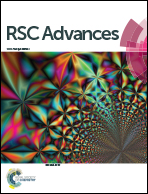Metallophthalocyanine derivatives utilized as cathode interlayers for polymer solar cells: a practical approach to prepare a uniform film†
Abstract
Three metallophthalocyanine derivatives: 2,3,9,10,16,17,23,24-octakis-[N-ethyl-(3-pyridyloxy)]vanadylphthalocyanine bromine (1 : 8) (VOPc(OPyC2H5Br)8), 2,3,9,10,16,17,23,24-octakis-[N-butyl-(3-pyridyloxy)]vanadylphthalocyanine bromine (1 : 8) (VOPc(OPyC4H9Br)8) and 2,3,9,10,16,17,23,24-octakis-[N-hexyl-(3-pyridyloxy)]vanadylphthalocyanine bromine (1 : 8) (VOPc(OPyC6H13Br)8) were synthesized and applied in polymer solar cells (PSCs) based on PTB7:PC71BM (PTB7 = thieno[3,4-b]thiophene/benzodithiophene, PC71BM = [6,6]-phenyl C71-butyric acidmethyl ester) as an active layer. As a result, the highest power conversion efficiency (PCE) value of the PSCs is 7.99% for the device with VOPc(OPyC2H5Br)8 as a cathode interlayer. Although increasing the alkyl side chains attached to the pyridine functional groups of phthalocyanine leads to a slight decrease of PCE, VOPc(OPyC6H13Br)8 can form a better, denser and more uniform film on the active layer as demonstrated by atomic force microscopy, energy dispersive spectrum mapping and contact angle measurements.


 Please wait while we load your content...
Please wait while we load your content...